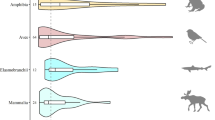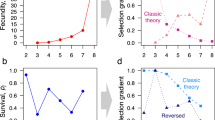Abstract
NATURAL survivorship curves fall into three main types1,2. Type I, or rectangular distribution, describes the situation in which all individuals attain the maximum physiological longevity of the species. Here the maximum age at death and the mean life expectancy coincide. The Type II life table describes a mortality which is independent of age; that is, no single age group is favoured at the time of dying. The Type III table is characterised by a high mortality early in life and a life expectancy which increases with the age of survivors. The three types of curve are illustrated in Fig. 1. The general shape of the survivorship curve is fixed for each species, however, the convexity of the curve is highly sensitive to environmental conditions and the genetic constitution of the population. This fact suggests that the general shape of the life table may provide information about the genetic variability in the population, the range of environmental factors that impinge on the population or the incidence of random events in the lifetimes of different individuals3. This note characterises in terms of two new demographic parameters the relative effect genetic and environmental factors play in the evolution of the life table. The analysis we give revolves around two demographic variables, the entropy of a population and the adaptive value. Entropy H measures the variability of the mortality distribution. The measure of variability also describes the convexity of the life table. The adaptive value ψ is a measure of the correlation between the variability of the mortality distribution and the environmental variability. Thus the adaptive value reduces to the entropy when the environment is constant.
This is a preview of subscription content, access via your institution
Access options
Subscribe to this journal
Receive 51 print issues and online access
$199.00 per year
only $3.90 per issue
Buy this article
- Purchase on Springer Link
- Instant access to full article PDF
Prices may be subject to local taxes which are calculated during checkout
Similar content being viewed by others
References
Pearl, R. & Miner, J. Q. Rev. Biol. 10, 60–79 (1935).
Deevey, E. S. Q. Rev. Biol. 22, 283–314 (1947).
Slobodkin, L. Growth and Regulation of Animal Populations (Holt, Rinehart and Winston, New York, 1961).
Demetrius, L. Proc. natn. Acad. Sci. U.S.A. 71, 4645–4647 (1974).
Keyfitz, N. Applied Mathematical Demography (Wiley Interscience, New York, 1977).
Demetrius, L. Proc. natn. Acad. Sci. U.S.A. (in the press).
Author information
Authors and Affiliations
Rights and permissions
About this article
Cite this article
DEMETRIUS, L. Adaptive value, entropy and survivorship curves. Nature 275, 213–214 (1978). https://doi.org/10.1038/275213a0
Received:
Accepted:
Issue Date:
DOI: https://doi.org/10.1038/275213a0
This article is cited by
-
Why life expectancy over-predicts crude death rate
Genus (2023)
-
Trends in mortality patterns in two countries with different welfare models: comparisons between Cuba and Denmark 1955–2020
Journal of Population Research (2023)
-
Impact of relative humidity and water availability on the life history of the predatory mite Amblyseius swirskii
BioControl (2021)
-
Keyfitz entropy: investigating some mathematical properties and its application for estimating survival function in life table
Mathematical Sciences (2021)
-
The long lives of primates and the ‘invariant rate of ageing’ hypothesis
Nature Communications (2021)
Comments
By submitting a comment you agree to abide by our Terms and Community Guidelines. If you find something abusive or that does not comply with our terms or guidelines please flag it as inappropriate.



